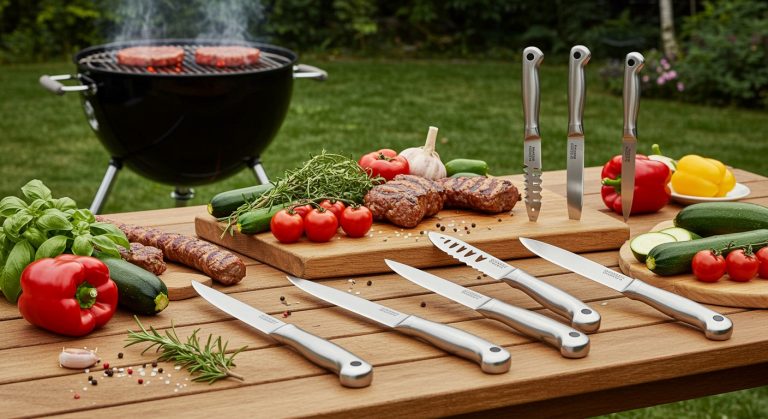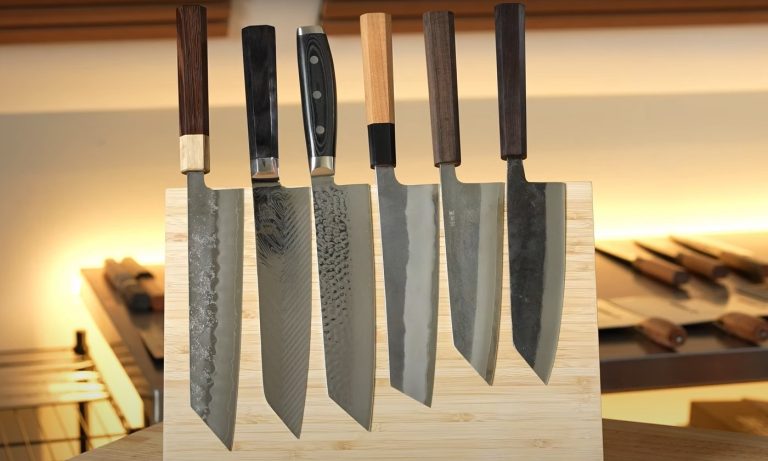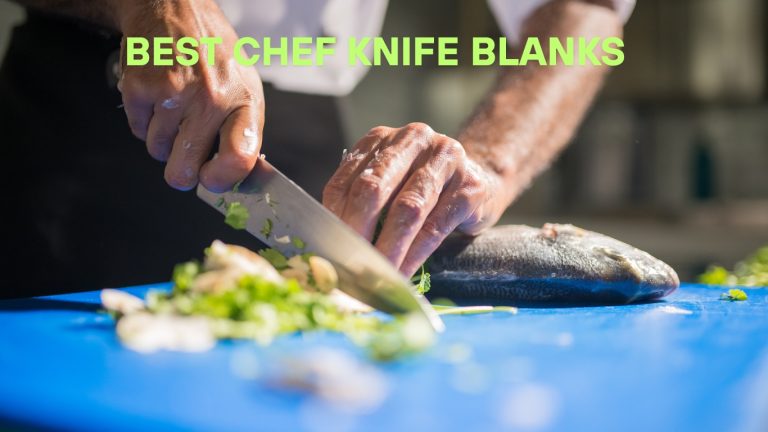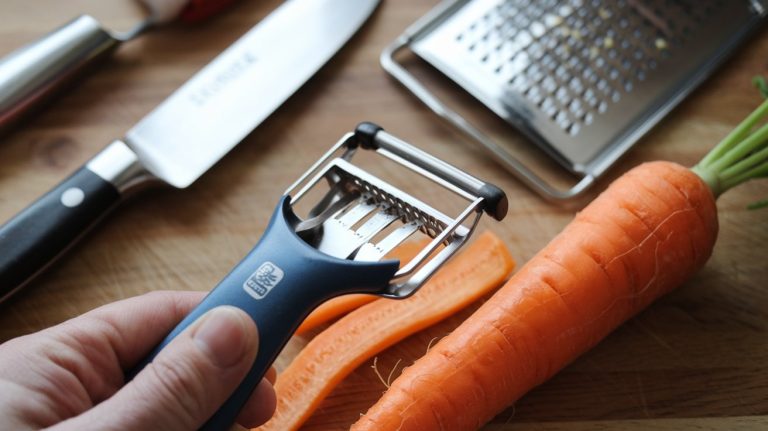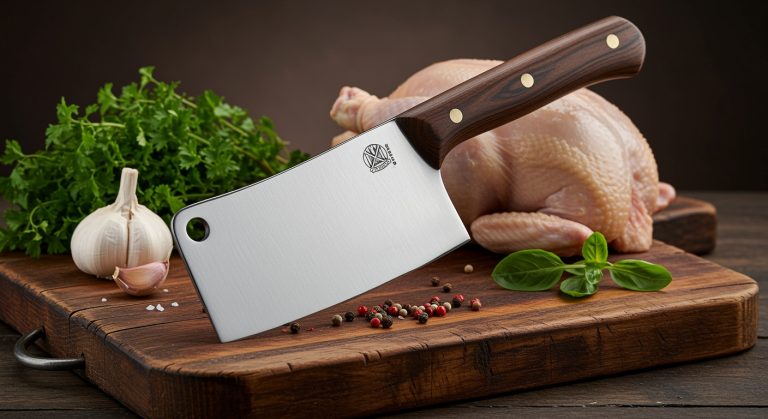Boning Knife Vs Fillet Knife: Which One is Best for You?
When you compare a boning knife and a fillet knife, each has its unique purpose. Boning knives are perfect for deboning meat and trimming fat, thanks to their thicker, stiffer blades.
On the flip side, fillet knives excel at slicing delicate fish due to their flexible, curved design.
While both can tackle various kitchen tasks, knowing when to use each one will enhance your food prep skills. Explore further to uncover how to choose the right knife for your culinary needs.
Key Takeaways
- Boning knives are thicker and stiffer, ideal for deboning meat and handling tougher cuts, while fillet knives are more flexible for delicate fish preparation.
- Boning knife blades typically range from 5 to 11 inches, whereas fillet knives are usually 5 to 9 inches long for maneuverability.
- Boning knives excel at precision work around bones and joints, while fillet knives allow for smooth cuts along a fish’s natural curves.
- Both knives are crafted from high-quality materials but differ in weight, with boning knives being heavier for control and fillet knives lighter for precision.
- Boning knives are versatile for various kitchen tasks like trimming fat, while fillet knives focus on creating perfect fillets with delicate cuts.
Purpose and Use of Boning and Fillet Knives
When it comes to preparing various types of proteins, understanding the purpose and use of boning and fillet knives is essential.
Boning knives excel at deboning meat, separating bones from poultry and larger cuts. They’re also great for trimming fat and connective tissue, providing precise cuts that minimize waste.
Though less flexible than fillet knives, boning knives can still fillet fish and handle fruits and vegetables with precision. A boning knife is designed specifically for maneuvering around joints and bones, further enhancing its utility in meat preparation.
Additionally, using a razor-sharp boning knife is crucial for achieving clean cuts and maintaining control during preparation.
On the other hand, fillet knives shine when it comes to fish. Their flexible blades maneuver around bones, allowing for delicate cuts required for dishes like sashimi.
Both knives offer versatility and precision, making them invaluable tools in any kitchen. Knowing when to use each will elevate your culinary skills.
Blade Design Differences
When comparing the blade design of boning and fillet knives, you’ll notice distinct differences in thickness and shape.
Boning knives are generally thicker and more rigid, making them ideal for cutting through tougher meat and connective tissue. Additionally, the blade length of boning knives typically ranges from 5 to 7 inches, providing a sturdy option for more demanding tasks.
In contrast, fillet knives feature a flexible, curved blade that allows for precise cuts around delicate fish, enhancing your overall cutting experience.
Blade Thickness Comparison
The blade thickness of boning and fillet knives reflects their distinct purposes and design features.
Boning knives typically have a thicker blade, ranging from 0.060 to 0.065 inches, allowing you to tackle tough bones and denser cuts of meat effectively.
Their sturdiness is essential for separating meat from bone without chipping. Additionally, boning knives are designed with a rigid spine that aids in cutting small joints with precision.
In contrast, fillet knives are thinner, prioritizing precision and flexibility for delicate fish. This design enables you to make clean, accurate cuts while filleting.
Both knife types use high-carbon or stainless steel, but the focus for fillet knives is on maintaining flexibility.
Blade Shape Characteristics
Understanding the differences in blade thickness naturally leads to an exploration of blade shape characteristics, which further defines the functionality of boning and fillet knives.
Boning knives feature a straighter design with a less pronounced curve, making them ideal for precision work around bones. Their pointed tips excel at piercing through tough connective tissues. This rigidity makes boning knives particularly effective for removing meat from bones and skin.
In contrast, fillet knives possess a more pronounced upward curve, allowing for smooth, long cuts in delicate fish. While both knives generally range from 5 to 8 inches, fillet knives can be shorter for smaller fish.
Flexibility of Blades
When choosing between a boning knife and a fillet knife, the flexibility of the blade plays a vital role in their performance.
Boning knives are stiffer, giving you the strength needed for tougher tasks like deboning meat, while fillet knives offer the flexibility essential for precise cuts around fish bones and skin.
This blade flexibility is crucial in determining which knife will provide the best control and precision for your specific cooking tasks.
Boning Knife Stiffness
Choosing the right stiffness in a boning knife can markedly impact your efficiency in the kitchen.
Stiff boning knives are perfect for tackling tougher cuts of meat, like pork or beef, as they provide excellent control when cutting through connective tissue. Their rigid blades, typically 5 to 7 inches long, excel at removing bones from larger cuts while maintaining precision.
Stiffer blades are better for larger cuts, while flexible blades excel in detail work around smaller bones. Additionally, a single bevel knife can provide clean cuts for delicate tasks, showcasing the importance of selecting the right knife for specific needs.
On the other hand, while flexible knives can contour around delicate bones, they’re less common and often serve dual purposes. If you’re looking for versatility, a stiff boning knife is your best bet; it can handle various tasks beyond just boning.
Fillet Knife Flexibility
The flexibility of a fillet knife plays an essential role in its performance, particularly when working with fish. This flexibility allows you to navigate around bones and skin with precision, making cleaner cuts without tearing the flesh.
Typically longer than boning knives, fillet knives excel in filleting whole fish, ensuring minimal waste thanks to their thin blades that reduce drag. For ideal handling, look for a blade with at least 15% flex to bend easily under pressure.
This flexibility not only aids in slicing fish but also enhances safety, as it minimizes the risk of slipping.
A flexible fillet knife can even tackle other tasks like segmenting fruits or mincing vegetables, making it a versatile kitchen tool. Lower angles enhance slicing capabilities during skinning by creating space between the fillet and skin.
Blade Length Considerations
Understanding blade length is essential when selecting between a boning knife and a fillet knife, as each serves different culinary purposes.
Boning knives typically range from 5 to 11 inches, while fillet knives are usually 5 to 9 inches long. If you need precision around joints, a shorter boning knife offers better control. For larger fish, a longer fillet knife helps achieve smooth cuts.
Conversely, shorter fillet knives are ideal for smaller fish. Additionally, boning knives are designed for cutting through connective tissue, making them particularly effective for meat preparation.
Consider that both types often fall within the 5-to-8 inch range, making them versatile.
Weight and Material Comparison
When selecting between a boning knife and a fillet knife, weight and material play essential roles in performance and usability.
Boning knives are generally heavier due to their thicker, sturdier construction, making them ideal for tougher tasks like cutting through connective tissue.
Fillet knives are lighter, enhancing precision and control for delicate cuts, such as filleting fish. This weight difference allows chefs to choose the right tool based on the specific requirements of their culinary tasks.
Both knives are often crafted from high-quality materials like stainless steel or high carbon steel, impacting durability and edge retention. Stainless steel resists corrosion, while high carbon steel offers superior sharpness.
The handle materials can vary too, with options like wood and polypropylene, each providing unique benefits.
Choosing the Right Knife for Your Needs
How do you determine which knife best suits your culinary needs? It comes down to understanding your cooking habits, the types of proteins you prepare, and the knife’s design features. Here’s a quick comparison to help you decide:
| Feature | Fillet Knife | Boning Knife |
|---|---|---|
| Blade Length | Longer for smooth fish filleting | Shorter for precise meat cuts |
| Blade Flexibility | More flexible for delicate fish | Stiffer for tougher cuts |
| Cooking Frequency | Ideal for frequent fish cooking | Best for meat preparation |
Task-Specific Applications
Choosing the right knife goes beyond just preference; it’s about matching the knife to the specific tasks you’ll tackle in the kitchen. Boning knives and fillet knives serve distinct purposes:
- Deboning Poultry: Boning knives excel at removing chicken breasts and maneuvering wing joints.
- Fish Filleting: Fillet knives allow smooth cuts along the fish’s natural curves for perfect fillets.
- Precision vs. Delicacy: Boning knives provide precision cutting around bones, while fillet knives focus on delicate cuts in soft fish. The boning knife’s rigid blade is particularly advantageous for deboning land animals.
- Connecting Tissues: Boning knives tackle tougher connective tissues, whereas fillet knives handle skin and scales effortlessly.
Versatility of Knives
While both boning and fillet knives are designed for specific tasks, their versatility extends far beyond traditional meat and fish preparation.
Boning knives excel in cutting around smaller bones and can trim fat from various meats like chicken and beef. Their flexible design makes them perfect for delicate tasks, ensuring precise cuts in poultry and fish.
The flexibility of the blade allows for maneuverability around bones and joints, making it a preferred choice for many chefs.
On the other hand, fillet knives shine with their longer blades, allowing smooth, uninterrupted cuts along fish bodies.
Beyond culinary uses, boning knives can handle crafting, floral arrangements, and even product manufacturing.
Both knives also perform well with fruits and vegetables, showcasing their adaptability in the kitchen.
Maintenance and Care for Longevity
To guarantee the longevity of your boning and fillet knives, proper maintenance is essential. By following these tips, you can keep your knives in top condition:
- Cleaning: Always wash your knives with warm, soapy water and dry them with a soft cloth. Avoid dishwashers and harsh chemicals.
- Storage: Use magnetic strips or cork-lined holders for safe storage. Make certain you keep knives organized and in a dry environment to prevent rust. The use of magnetic strips for storage also helps maintain the knife’s edge by preventing contact with hard surfaces. Proper knife storage can help avoid dullness and damage.
- Sharpening: Regularly sharpen your knives every 2-3 months with a whetstone and maintain the edge with a honing steel.
- Corrosion Prevention: Apply food-safe oil to carbon steel blades and rinse immediately after cutting acidic foods to prevent corrosion.
Frequently Asked Questions
Can I Use a Boning Knife for Filleting Fish?
Yes, you can use a boning knife for filleting fish, but it’s not ideal.
While the boning knife’s rigidity offers some control, it lacks the flexibility needed for precise cuts.
You might find it challenging to separate the flesh cleanly from the bones without damaging the fish.
For the best results, it’s better to use a fillet knife, which is specifically designed for this delicate task and provides better yield.
What Are Common Brands for Quality Boning and Fillet Knives?
When searching for quality boning and fillet knives, consider popular brands known for their craftsmanship.
For boning knives, you might check out Knives of Alaska, Victorinox, and Shun, each offering durability and comfort.
For fillet knives, Dalstrong and Global stand out for their sharpness and flexibility.
No matter your choice, prioritize ergonomic designs and high-quality materials to guarantee you get the best performance in your kitchen tasks.
How Often Should I Sharpen My Boning or Fillet Knife?
You should sharpen your knife every 1-2 months if you’re a home cook, while professionals may need to sharpen weekly due to heavier use.
The type of steel and what you’re cutting also affect how often you sharpen.
Regular honing can help maintain the edge longer, so don’t skip that step.
Pay attention to how easily your knife cuts; if it struggles, it’s time for sharpening!
Are There Specific Techniques for Using Each Knife Effectively?
Yes, there are specific techniques for using each knife effectively.
For precise cuts, grip the handle firmly and maintain a 15–20-degree angle for ideal control.
When working with bones, use the tip to guide along natural separations.
For fish, apply gentle pressure, keeping the blade low to glide smoothly between skin and flesh.
Can I Find a Knife That Combines Features of Both Types?
Like a skilled painter choosing the right brush, you can indeed find knives that combine features of both types.
Hybrid knives, such as the Cutluxe 6-Inch Boning & Fillet Knife, offer flexibility for filleting delicate fish while maintaining precision for deboning meat.
Crafted from high-quality materials, these versatile tools allow you to tackle various culinary tasks seamlessly.
While they may not outshine specialized knives, they provide a convenient solution for your kitchen needs.
The Key to Confident Cooking with the Right Knife
In the culinary world, choosing between a boning knife and a fillet knife is like selecting the right tool for a masterful painting.
Each knife serves a distinct purpose, whether you’re deftly removing bones or delicately filleting fish. By understanding their unique designs and applications, you can elevate your kitchen skills and achieve precision in your cooking.
So, wield your chosen knife with confidence, and let your culinary creations shine like a masterpiece on the plate.


